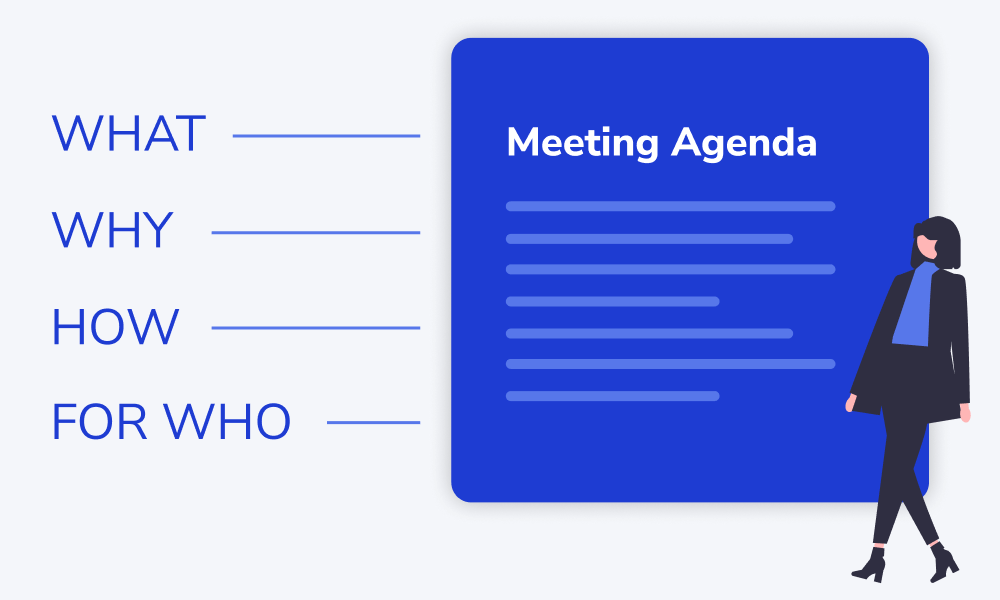In the world of sales, where targets are always on the horizon, effective communication is the key to staying ahead. Internal sales meetings serve as a crucial platform to exchange ideas, set goals, and address challenges.
But how do you ensure these meetings are not just routine gatherings but driving forces for your team's success? The answer lies in a well-crafted sales meeting agenda.
In this article, we’ll look at the vital components of sales meeting agenda and how to create one. We will also delve into the common mistakes to avoid and provide practical examples to illustrate effective agendas in action.
Are you ready to unlock the power of an effective sales meeting agenda? Let’s transform your sales meetings from just another item on the calendar to a potent tool for success.
Let’s kick off by understanding the basic foundation: what exactly is a sales meeting, and why is it important?
Table of Contents:
-
Sales Meeting Definition and Meaning: What is a Sales Meeting?
- The Undeniable Importance of a Robust Sales Meeting Agenda
- 6 Essential Elements of a Well-Prepared Sales Meeting Agenda
- How to Create an Effective Sales Meeting Agenda
- Examples of Sales Meeting Agendas
- Dodging the Pitfalls: Common Mistakes to Avoid When Crafting Your Sales Meeting Agenda
- Examples of Sales Meeting Agendas
- Summary
Sales Meeting Definition and Meaning: What is a Sales Meeting?
In this article, we focus on discussing internal sales team meetings only. To begin, let's clarify the concept of an internal sales meeting. Essentially, a sales meeting serves as a designated gathering for a company's sales team and other relevant people–all convened with a specific sales-related purpose in mind.

So, in a nutshell:
What
Structured discussion designed to help the sales team achieve their targets, align their strategies, ideate together, share company announcements, or solve specific issues. This is when you’ll have topics that could range from discussing sales strategies, policies, procedures, the company's products or services, incentives, targets, reviewing performance metrics, exploring potential opportunities, or even team-building activities.
Why
The purpose of a sales meeting is multifaceted. It is not only aimed at increasing sales but also enhancing team cooperation, communication, setting clear goals, and maintaining the overall health of the sales team. Without regular sales meetings, sellers might find themselves working without a defined direction, leading to lower productivity and missed opportunities.
How
A successful sales meeting starts with a well-constructed sales meeting agenda. It ensures the meeting stays focused, manages time efficiently, and brings actionable results. The effectiveness of a sales meeting often hinges on the effectiveness of its agenda.
For Who
Internal sales meetings are primarily for the sales team, but depending on the topics under discussion, other participants could include product developers, marketing team members, or even executives. For example, if the meeting's objective is to understand a new product's features, having a product developer present could provide valuable insights.
The Undeniable Importance of a Robust Sales Meeting Agenda
A sales meeting agenda is a layout that outlines the subjects to be discussed at a sales meeting. It sets clear expectations, maintains the meeting's flow, and ensures that the team's time is used productively.
By establishing the agenda beforehand, the team knows what to expect, they can prepare accordingly, and everyone's time is respected.
For example, your sales team is meeting to plan for an upcoming sales quarter. Without an agenda, the meeting could easily become a chaotic discussion with no clear direction or outcomes. By establishing the agenda beforehand, the team knows what to expect, they can prepare accordingly, and everyone's time is respected. The meeting becomes a productive session leading to actionable outcomes rather than just a routine gathering.
The Advantages of a Well-Prepared Sales Meeting Agenda
Often, the importance of a sales meeting agenda is underestimated. However, research consistently shows that organized meetings lead to better outcomes and higher productivity.
Meetings with a well-planned agenda are shorter, more productive, and leave participants more satisfied. By planning the meeting and preparing the sales meeting agenda in advance, you maximize efficiency and the outcomes.
A meticulously crafted sales meeting agenda wields significant power, enabling sales leaders to:
- Streamline Sales Meetings: By instilling structure, an agenda keeps the meeting focused, minimizing potential distractions and off-topic discussions that can dilute the meeting's effectiveness.
- Promote Transparent Communication: It facilitates the sharing of team priorities, ensuring that everyone is attuned to the collective objectives. This transparency cultivates a shared vision and mitigates misunderstandings.
- Amplify Sales Reps' Accountability: The agenda provides a platform for reviewing sales performance. This practice promotes individual responsibility towards targets, fostering an atmosphere of accountability that can drive sales growth.
- Strengthen Team Collaboration and Performance: By carving out space for open dialogues, the agenda encourages team bonding. Such discussions can spark innovative ideas, deepen understanding, and create a positive team spirit that can propel collective performance.
- Facilitates Efficient Time Management: A clear agenda allows meetings to start and end on time, respecting everyone's schedule and improving overall productivity.
- Provides a Tangible Reference: The meeting agenda serves as a practical reference, both during and after the meeting, helping all participants track progress and remember key points.
- Encourages Equitable Participation: By laying out discussion points in advance, a sales meeting agenda can empower every member to prepare and contribute, promoting a more balanced and inclusive dialogue.
So, the bottom line? If you want to conduct effective sales meetings that drive results, never underestimate the power of a well-planned sales meeting agenda.
6 Essential Elements of a Well-Prepared Sales Meeting Agenda
There are five fundamental elements to consider when drafting a sales meeting agenda:
1) Objective Setting
Each meeting should have a clear and specific objective. Whether it's discussing new strategies or reviewing quarterly sales, the objective sets the tone and direction for the meeting.
2) Time Management
Allocate a specific timeframe for each agenda item to prevent the meeting from running overtime. This encourages participants to stay on topic and promotes efficiency.
3) Participant Roles
Defining roles helps prevent confusion during the meeting. Whether it's the facilitator, note-taker, or presenter, everyone should know their responsibilities before the meeting commences.
4) Discussion Topics
These are the heart of your sales meeting agenda. The topics should align with the meeting's objective and be relevant to the participants.
Read more about 20 Key Sales Meeting Topics to Cover With Your Team and How To Prioritize →
5) Preparation Requirements and Preparation Materials
For maximum productivity, participants should come prepared. Your agenda should include all necessary preparation materials - such as sales reports or competitor analyses - and specify what is expected from each team member. This ensures well-informed discussions and facilitates active participation.
6) Follow-ups and Action Items
Assign and track responsibilities. This ensures that decisions made in the meeting translate into action, and it holds team members accountable.
Want to learn more about sales meeting topics to drive sales team performance? Read next:
20 Key Sales Meeting Topics to Cover With Your Sales Team And How To Prioritize →
How to Create an Effective Sales Meeting Agenda
Creating a successful sales meeting agenda involves considering each of the above elements in detail.
- Start by defining the meeting's objective and then list down the discussion topics.
- Assign time frames to each point, keeping in mind their relevance and importance.
- Identify the roles of each participant and communicate these before the meeting.
- Finally, ensure that there's a system in place for tracking follow-ups and action items.
For example, if your objective is to boost sales for the next quarter, your discussion topics could include analyzing past performance, brainstorming new strategies, and identifying potential roadblocks. Assign reasonable time frames to each topic, keeping the most important ones for when the team is most alert.
Examples of Sales Meeting Agendas
Understanding the components of a successful sales meeting agenda is one thing, but visualizing it in action can provide a clearer perspective. Here, we delve into a few examples of effective sales meeting agendas that cater to different objectives:
Weekly Sales Team Check-in Agenda
Objective:
- To assess weekly sales progress and address any immediate issues or roadblocks
Agenda:
- Welcome and Briefing (5 minutes)
- Individual Sales Updates and Challenges (25 minutes - 5 minutes per team member)
- Open Discussion and Problem-Solving (15 minutes)
- Sales Tips or Training (5 minutes)
- Review of Next Week's Goals (5 minutes)
-
Follow-ups and Action Items (5 minutes)
Quarterly Sales Strategy Meeting
Objective:
- To review the previous quarter's performance and plan the sales strategy for the next quarter
Agenda:
- Welcome and Briefing (5 minutes)
- Previous Quarter Performance Review (30 minutes)
- Discussion on Upcoming Quarter Sales Targets and Strategies (45 minutes)
- Identification of Potential Challenges and Solutions (20 minutes)
- Defining Roles. Responsibilities and Action Items (10 minutes)
New Product Sales Meeting Agenda
Objective:
- To understand the features of a new product and develop a sales strategy for it.
Agenda:
- Welcome and Briefing (5 minutes)
- Detailed Presentation of the Product Features (30 minutes)
- Brainstorming Session for Sales Strategy (30 minutes)
- Assigning Tasks. Setting Goals and Action Items (20 minutes)
These examples can serve as a blueprint when creating your own sales meeting agendas. Remember, the agenda should be flexible and cater to your specific objectives and team needs. A well-crafted agenda is your first step towards a successful and productive sales meeting.
Dodging the Pitfalls: Common Mistakes to Avoid When Crafting Your Sales Meeting Agenda

When it comes to creating a sales meeting agenda, even the best of us can stumble. Here are some common missteps to be mindful of, along with strategies to sidestep them:
Lacking a Clear Objective: Without a specific objective, a meeting can quickly turn into a directionless discussion. For instance, if your meeting's objective is vaguely defined as 'improving sales', it can lead to multiple tangents without any actionable outcome. To prevent this, set a clear and specific objective, such as 'Identifying strategies to increase sales of Product X by 15% in the next quarter.
Inefficient Time Management: It's easy to underestimate or overestimate the time each agenda item might take. For example, if a vital topic is given 5 minutes, it may lead to rushed discussions and unsatisfactory conclusions. On the other hand, if a less important topic is allocated 30 minutes, it could lead to a drawn-out conversation that saps the energy from the meeting. To avoid this, assign realistic timeframes based on the topic's importance and complexity.
Overcrowded Agenda: Packing too many topics into one meeting can leave your team feeling overwhelmed and fatigued. Suppose you're planning to discuss sales strategies, review performance, train the team on a new product, and plan for the next quarter all in one meeting. The result could be an exhausting 3-hour marathon that leaves your team drained. Instead, prioritize your topics and plan separate meetings if needed.
Undefined Participant Roles: When roles aren't clearly defined, it can lead to confusion and miscommunication. For instance, if two people assume they're leading the meeting, it could result in a power struggle that derails the conversation. To avoid this, assign roles clearly and communicate them to everyone before the meeting.
Neglecting Follow-Ups and Action Items: One of the most common mistakes is to have a productive discussion but forget to assign action items or follow-ups. This can render the entire meeting pointless. If your team discusses a brilliant strategy to increase sales, but no one is assigned to implement it, the strategy simply remains a good idea with no real-world impact. Always ensure that the meeting's decisions are translated into action items with assigned responsibilities.
Remember, a sales meeting agenda is a dynamic tool that should be tailored to your team's needs and meeting's objectives. By steering clear of these common mistakes, you can make your sales meeting agendas more effective, driving productive discussions and achieving your sales goals.
A Well-Crafted Sales Meeting Agenda is the Key to Successful Sales Meetings
In conclusion, a well-prepared sales meeting agenda is not just a tool, but a strategic asset that can significantly contribute to your team's performance and sales success. It aligns everyone's focus, fosters an atmosphere of accountability, encourages inclusive participation, and most importantly, it translates ideas into actionable tasks.
It's crucial to remember that every team is unique, and therefore, every sales meeting agenda should be tailored to fit your team's specific needs and objectives. When crafted thoughtfully, your agenda becomes a blueprint for success that can steer your meetings from being just another entry on your calendar to a potent engine driving your team toward its goals.
As we wrap up this comprehensive guide, our hope is that you are now equipped with the knowledge and insights to create effective sales meeting agendas that will transform your team meetings and propel your sales to new heights.
Happy planning, and here's to your team's success! 🥳
Curious about how the Showell Sales Enablement Platform can elevate your sales team's performance to new heights? Book a 30-minute demo by clicking the banner below or Get Showell Free today!
Learn next:
- 7 Essential Skills Your Team Needs to Achieve Sales Enablement Goals →
- Setting SMART Sales Enablement Goals: A Step-by-Step Guide →
- All You Need To Know About Sales Content Management →
- Answering Your Top Questions About Sales Enablement Plan →




.png?width=1000&height=400&name=Blog%20banner_%20Book%20demo%207%20(1).png)
